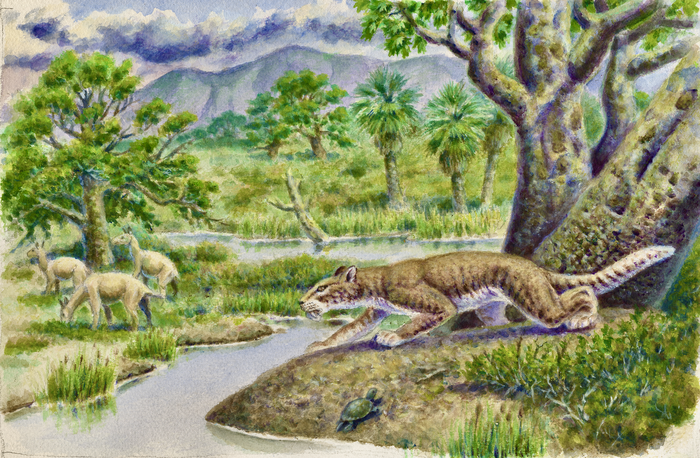Dogs, cats, and their close relatives — existing and extinct — are members of Carnivoramorpha, a group of mammals in which saber-like canines have evolved twice.

Credit: KyotoU/Jim Melli (San Diego Natural History Museum)
Dogs, cats, and their close relatives — existing and extinct — are members of Carnivoramorpha, a group of mammals in which saber-like canines have evolved twice.
Sabertoothed nimravids were early members of Carnivoramorpha, but dogs and cats did not evolve from them.
“Our specimen has serrated slicing teeth which have important similarities to later predators. The teeth tell us that close relatives of today’s living carnivores spread around the world earlier than we believed, and they diversified quickly when they reached new continents like North America,” explains lead author Ashley Poust.
By roughly 40 million years ago, saber-like canines evolved in an ancestral nimravid. By about 16 million years ago, saber-like canines also evolved in an ancestor of a cat subfamily called Machairodontinae, which would give rise to the genus Smilodon about 2.5 million years ago.
“So the nimravids were the original sabretooth carnivores among Carnivoramorpha,” explains corresponding co-author Susumu Tomiya of Kyoto University’s CICASP.
Now, the team of researchers has re-identified a fossil specimen collected in San Diego in 1997. Earlier, based solely on a partial upper jaw with only two intact teeth and missing saber-like canines, the specimen was misidentified as a Hyaenodon, a separate group of carnivorous mammals.
Further morphological analysis of the tooth shapes, helped to determine that the specimen was one of the earliest nimravids dating back 37 to 40 million years.
“We are excited to honor Dr Naoko Egi, who has added so much to our knowledge of carnivore evolution, by renaming our find as Pangurban egiae,” Poust adds.
“The stressed tropical and subtropical ecosystems and movement of species 38 million years ago that resemble changes happening today may have driven the evolution and rise of hypercarnivorous carnivoramorphans, particularly the nimravids.”
The first nimravids possibly originated in Asia, and after migrating across vast land masses that are now today’s continents, inhabited western North America.
“The discovery of Pangurban egiae reminds us how quickly invasion and adaptation can occur and the large role it has played in the history of life,” concludes Poust.
###
The paper “An early nimravid from California and the rise of hypercarnivorous mammals after the middle Eocene climatic optimum” appeared on 12 October 2022 in Biology Letters with doi: 10.1098/rsbl.2022.0291
KyotoU paper repository: http://hdl.handle.net/2433/276689
About Kyoto University
Kyoto University is one of Japan and Asia’s premier research institutions, founded in 1897 and responsible for producing numerous Nobel laureates and winners of other prestigious international prizes. A broad curriculum across the arts and sciences at both undergraduate and graduate levels is complemented by numerous research centers, as well as facilities and offices around Japan and the world. For more information, please see: http://www.kyoto-u.ac.jp/en
Journal
Biology Letters
DOI
10.1098/rsbl.2022.0291
Method of Research
Meta-analysis
Subject of Research
Animals
Article Title
An early nimravid from California and the rise of hypercarnivorous mammals after the middle Eocene climatic optimum
Article Publication Date
12-Oct-2022
COI Statement
The authors declare no competing interests.




